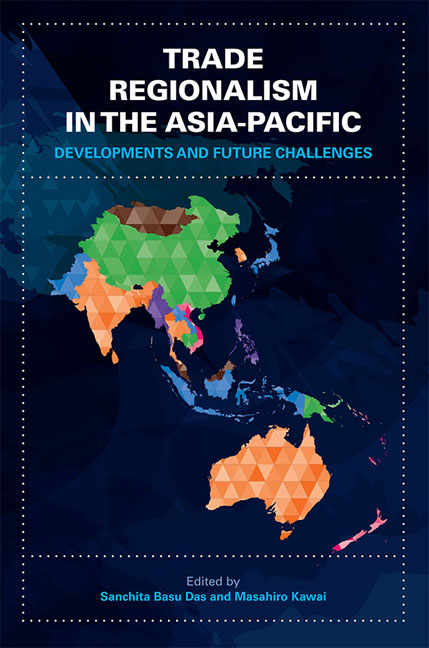Book contents
- Frontmatter
- Contents
- Foreword
- Acknowledgments
- List of Abbreviations
- The Contributors
- 1 Introductory Overview — Trade Regionalism in the Asia-Pacific: Developments and Future Challenges
- I The Trans-Pacific Partnership (TPP) Agreement
- II The Regional Comprehensive Economic Partnership (RCEP) Agreement
- III Regional Economic Integration: A Multi-stage Approach
- IV Old and Emerging Approaches to Asia-Pacific Regional Integration
- V Asia-Pacific Regional Integration: Towards Convergence?
- 15 APEC, TPP, and RCEP: Towards an FTAAP
- 16 The Implications of Mega-regional Trade Agreements on the World Trade Organization
- Index
16 - The Implications of Mega-regional Trade Agreements on the World Trade Organization
from V - Asia-Pacific Regional Integration: Towards Convergence?
Published online by Cambridge University Press: 05 July 2016
- Frontmatter
- Contents
- Foreword
- Acknowledgments
- List of Abbreviations
- The Contributors
- 1 Introductory Overview — Trade Regionalism in the Asia-Pacific: Developments and Future Challenges
- I The Trans-Pacific Partnership (TPP) Agreement
- II The Regional Comprehensive Economic Partnership (RCEP) Agreement
- III Regional Economic Integration: A Multi-stage Approach
- IV Old and Emerging Approaches to Asia-Pacific Regional Integration
- V Asia-Pacific Regional Integration: Towards Convergence?
- 15 APEC, TPP, and RCEP: Towards an FTAAP
- 16 The Implications of Mega-regional Trade Agreements on the World Trade Organization
- Index
Summary
INTRODUCTION
Mega-regional trade agreements are the most recent manifestation of regionalism since its revival in the 1980s. In the past five years, there has been much discussion about the effects of these so-called mega-regionals on the global economy, the most important of which are: the Regional Comprehensive Economic Partnership (RCEP), the Trans-Pacific Partnership (TPP), and the Transatlantic Trade and Investment Partnership (TTIP). An additional preferential initiative currently under consideration, although not yet under negotiation, is the Free Trade Agreement of the Asia-Pacific (FTAAP), encompassing the full membership of the Asia-Pacific Economic Cooperation (APEC). According to the World Economic Forum, megaregional trade agreements are defined as:
… deep integration partnerships in the form of RTAs [regional trade agreements] between countries or regions with a major share of world trade and FDI [foreign direct investment] and in which two or more of the parties are in a paramount driver position, or serve as hubs, in global value chains (i.e. the US, the EU, Japan, China) (Meléndez-Ortiz 2014, p. 13).
Thus, their size is what differentiates the RCEP, TPP, and TTIP from other Preferential Trade Agreements (PTAs) and makes their study unique and pertinent. As detailed in Table 16.1, the successful negotiation of the RCEP, TPP, or TTIP would create a vast integrated market across several countries, commanding a substantial portion of the world's trade and gross domestic product (GDP). Moreover, their officially proposed completion date of 2015 indicates the high level of priority that their members have accorded these prospective agreements. As we have seen with the TPP, however, a 2015 completion date may well prove elusive. The purpose of such integration in these mega-regionals is to provide increased market access, regulatory compatibility, and a “rules basket” to iron out variations in business and investment climates (Meléndez-Ortiz 2014, p. 13). Simply put, mega-regionals are large PTAs designed to facilitate trade liberalization among its members.
Yet, PTAs — including mega-regionals — are problematic “two-faced” arrangements because they offer free trade only to members and protection against non-members, as Jagdish Bhagwati reminds us (Bhagwati 2008, pp. 16–17).
- Type
- Chapter
- Information
- Trade Regionalism in the Asia-PacificDevelopments and Future Challenges, pp. 323 - 340Publisher: ISEAS–Yusof Ishak InstitutePrint publication year: 2016



